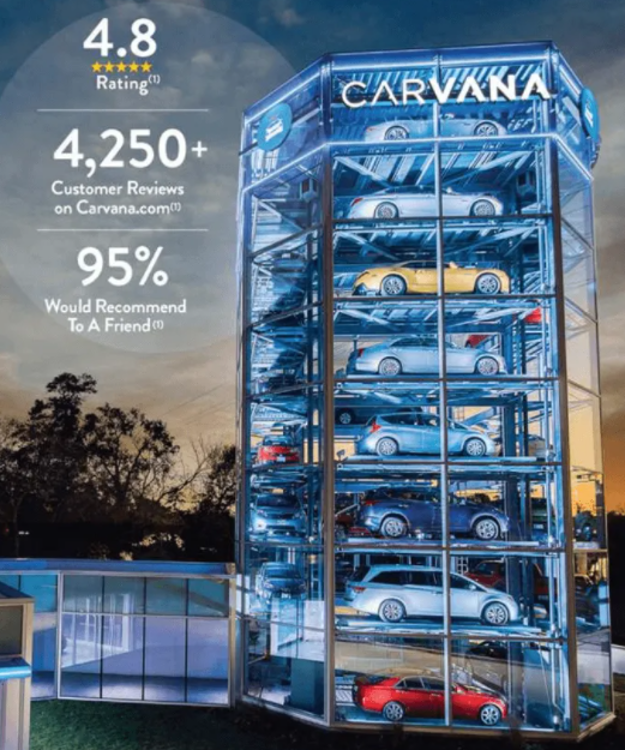Selling used cars isn’t the most glamorous of jobs, but that’s why it should just be moved online, right?
There have been many attempts to get this right, but many failures.
Now, we finally have something good brewing with Carvana (CVNA) who has tried to solve this issue in the U.S. by offering consumers a reliable e-commerce platform for buying and selling used cars.
Not only that, but the latest numbers they have concocted mean that investors might even eye them as a “growth” stock.
Last year was really a historic year for the buying and selling of cars in the U.S. as prolific levels of demand still outpaces the ability to scale production for many companies.
We saw more demand than we had ever seen before, and let’s face it, the supply couldn’t catch up.
And then that was kind of overlaid with three successive waves of a pandemic, which obviously have kind of impacted the entire supply chain and not just contained to cars.
It was a difficult year and investors can almost think about it as being three separate events that led to some supply-side constraints.
The team at Carvana has done an incredible job working out all of those three different events.
And I think that's evidenced by the growth that we saw last year despite the public health limitations.
Then we turned over to 2021, and the growth in January was more than expected.
To build inventory again, and then get hit with the next wave, and starting again are lessons that Carvana is beginning to take in stride.
Now that we are headed into a more normalized world, bottlenecks will solve themselves.
Looking at Carvana’s business, the devil is in the detail.
Buying cars from customers is a business that obviously continues to do incredibly well for Carvana which grew at 96% for 2020.
I do think the most impressive statistic is in the fourth quarter last year, of the cars that were sold to customers, 65% had been bought from customers.
To put that in context, two years ago, they set out a long-term goal of 38% to 52%.
So for roughly 2/3 of their cars that were sold to customers, they bought from other customers which inherently brings down the cost of acquiring goods when management isn’t out fishing in far-flung channels for the incremental car to acquire.
They grew at 80% in January and had only half of the available inventory of the year before, which is the better than expected growth I just mentioned.
There are longer delivery times than last year proving that there are still lingering hangovers from 2020.
Annual revenue totaled $5.6 billion, an increase of 42%, and retail units sold totaled 244,111, an increase of 37%, making them the second largest used automotive retailer in the U.S.
For the fourth quarter, retail units sold totaled 72,172, an increase of 43%. The total revenue was $1.8 billion, an increase of 65%.
In 2020, Carvana opened 120 new markets, bringing a year-end total to 266. With these new market openings, they now serve 74% of the U.S. population, up from 67% at the end of 2019.
They will continue to expand in 2021 and expect to serve 78% to 80% of the U.S. population in more than 300 markets by year-end.
In 2020, they also made significant progress scaling vehicle production capacity, and this continues to be an area of focus for the business.
They added four inspection and reconditioning centers (IRC) in 2020, bringing annual production capacity at full utilization to over 600,000 units at year-end.
I expect two more IRCs to open in 2021 and eight in 2022, ending 2022 with more than 1.25 million units of annual production capacity at full utilization.
Carvana’s eyes are squarely focused on achieving a goal of selling more than two million units per year. And they will continue to maintain a healthy pipeline of future IRCs to support accelerating growth.
I expect this robust momentum to continue while also showing significantly narrowing EBITDA loss margins.
And then when you think about the supply side, Carvana has a supply chain that enables them to deliver a car to a customer's door with a branded hauler and a uniformed Carvana team member to what they hope to be 80% of the U.S. population by the end of this year.
The last mile solution is critical to personalizing a service in 2021 and as the automotive industry at large evolves over the next decade or so, we are effectively seeing the modernization of it in real time.
Highly differentiated car buying experiences are here to stay.
With the growth metrics at the macro level and the fact they did $5.6 billion in revenue last year, Carvana is poised to forage ahead on an easy pathway to $10 billion in annual revenue.
This is becoming a used car selling heavyweight that is starting to really seep into the national consciousness.
No wonder the stock is up around 300% in the last 365 days and I believe any 10-15% dip should be bought in this stock.




